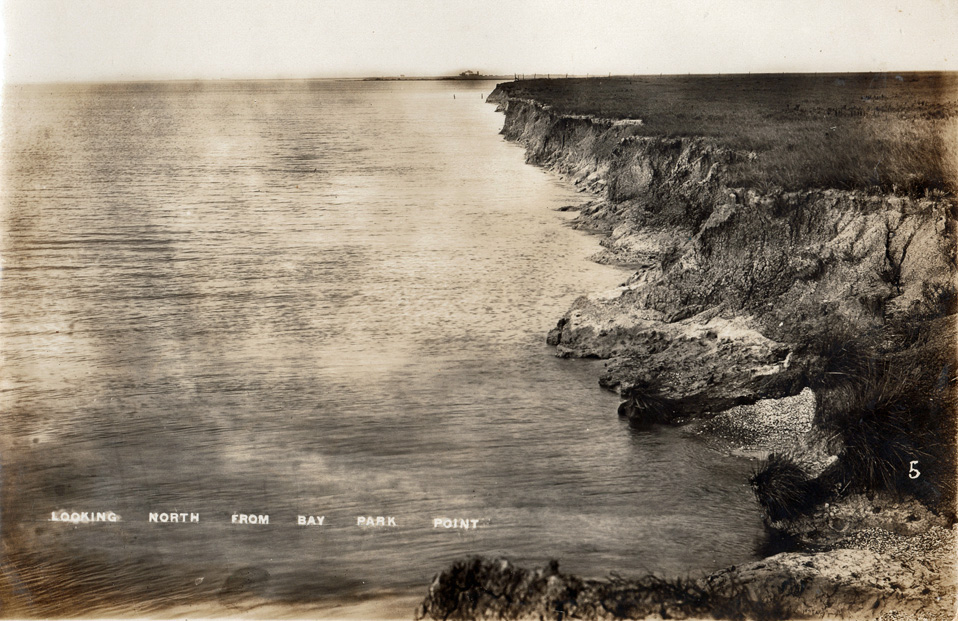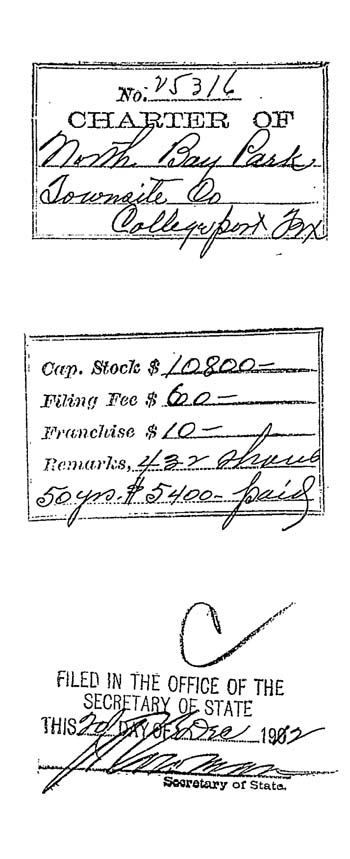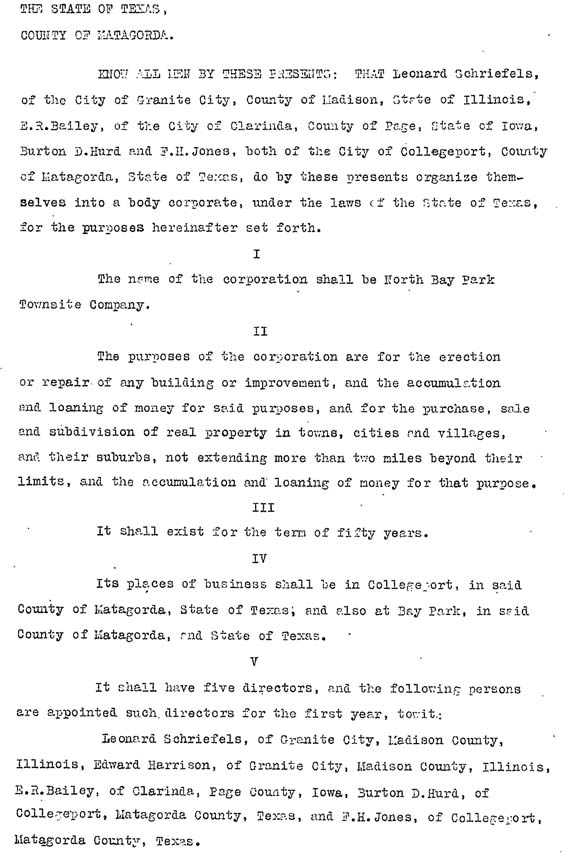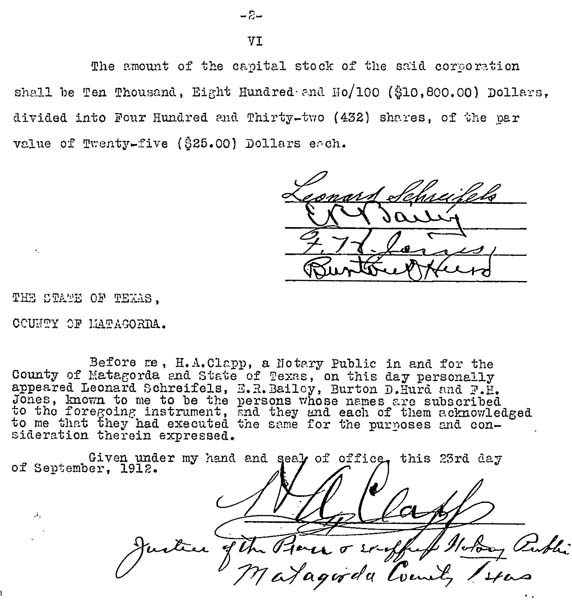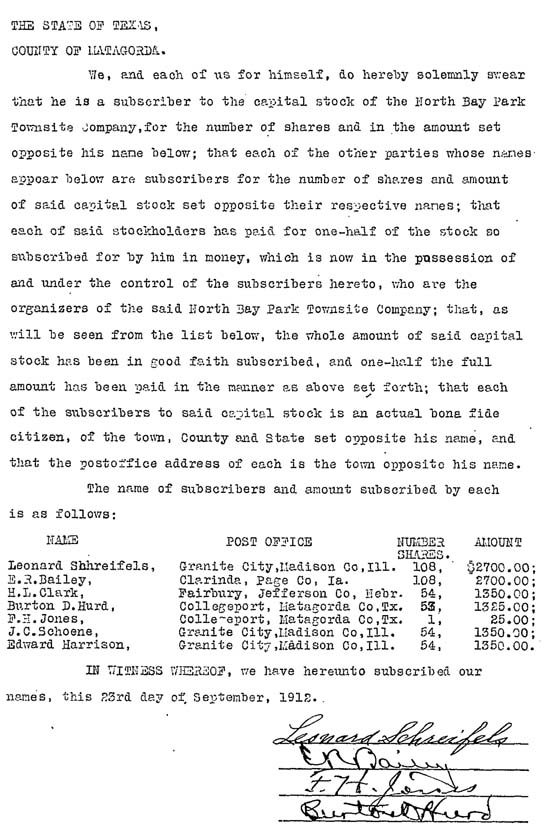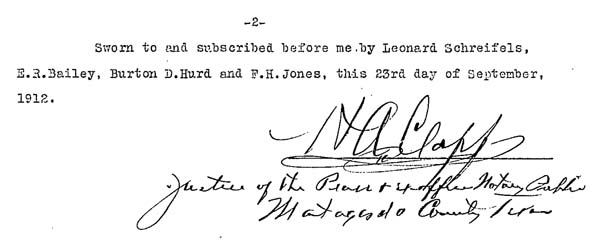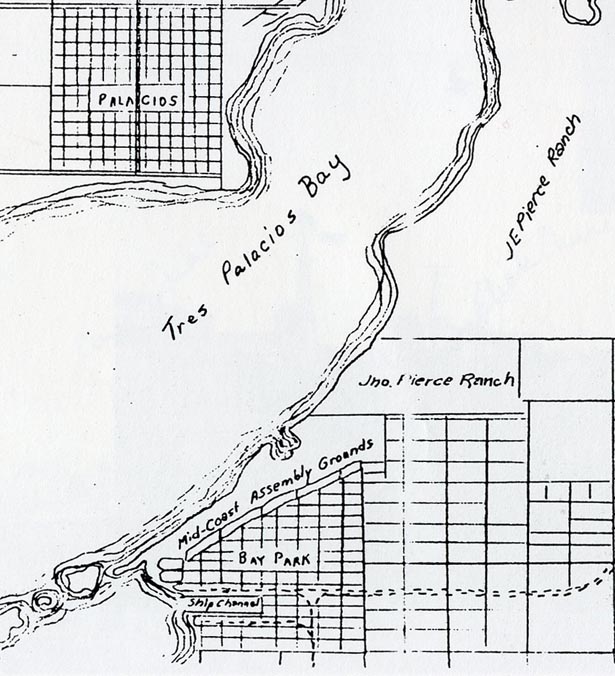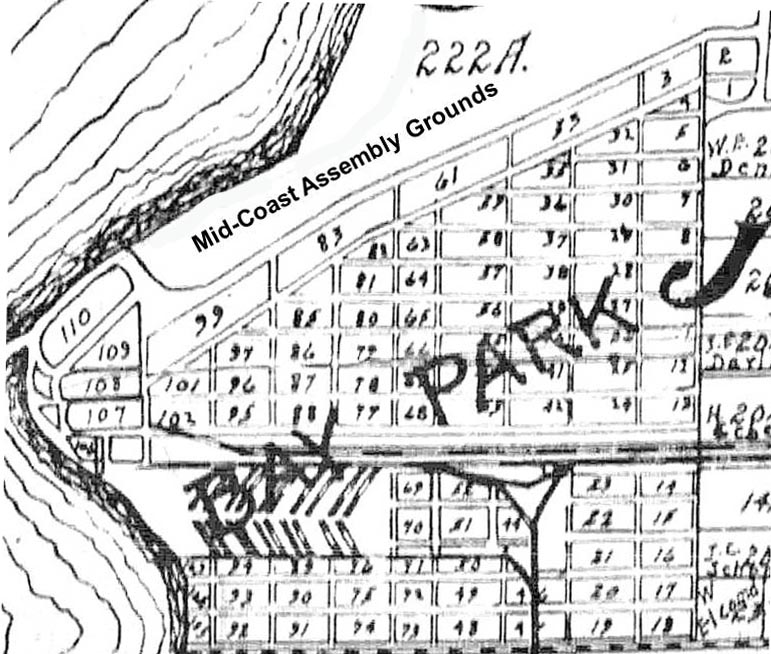|
|
||||||||||||||||||||||||||||||||||||||||||||||||||||||||||||||||||||||||||||||||||||||||||||||||||||||||||||||||||||||||
|
|
||||||||||||||||||||||||||||||||||||||||||||||||||||||||||||||||||||||||||||||||||||||||||||||||||||||||||||||||||||||||
|
In 1910 the Burton D. Hurd Land Company planned to build a townsite on the east coast of Tres Palacios near the two small islands called Shell Island. This was near the proposed site of Bay Side. A pavilion over the water, many parks, hotel grounds, and ship channels were planned for this townsite. The plans called for railroad lines to be laid from the present Collegeport area, terminating at the ship channels. Streets were named First through Seventh, and the avenues were designated A through K. Bay Park, however never developed.
Typed
by Faye Cunningham |
||||||||||||||||||||||||||||||||||||||||||||||||||||||||||||||||||||||||||||||||||||||||||||||||||||||||||||||||||||||||
|
Bay City, Texas, May 23.--Perhaps the greatest surprise that awaits the Northern visitor is the evident want of appreciation on the part of native Texans of the wonderful natural advantages of the Texas gulf coast. "A prophet is not without honor save in his own country." How few Texas people yet realize that this is a tested, tried and proven winter truck, garden, orange and citrus fruit country, winter and summer resort, a veritable New California; the one place with good soil, good water, good climate; all the requisites of pleasure and profit bunched. The only country on earth where oranges, citrus fruits, figs, berries and garden truck grow successfully side by side in the same fields with such crops as rice, ribbon cane, corn, cotton, alfalfa, oats, etc., and where several crops on the same ground are possible the same year. Among these great assets perhaps the greatest of all is our seashore--storm-protected, high and dry, with its bathing, boating, balmy breezes, natural summer and winter outing grounds and health repair shop for a strenuous Twentieth century nation. Some years ago the leading association men of the Kansas City and Chicago districts began casting about for a suitable gulf coast location for a great convention center and outing park, not a local affair, but for the great Middle West. They made a careful inspection from Florida to Brownsville, as a result of which John W. Hensel of Chicago, one of the foremost association men of the country, has now made a personal selection of 200 acres of bay front property for the Matagorda Bay Park congress of religion, education and public service, combined with health and recreation and located just out of Collegeport, which is situated on Matagorda bay twenty-five miles distant from Bay City, the county seat, where the new branch line of the St. Louis, Brownsville and Mexico railroad, with terminus at Collegeport, makes direct connections with the main line of the St. Louis, Brownsville and Mexico railway, the Southern Pacific and the Santa Fe systems. The land was donated by Burton D. Hurd, G. M. Magill and F. H. Jones of Collegeport and is out of one of the great J. E. Pierce ranches. These ranches are now all being settled under a very comprehensive plan, making such development as this park plan possible. The land set apart extends about one mile along the shore and includes one of the finest beaches on the bay and the grounds connect with a ninety-foot boulevard that follows the bay shore line for more than twenty miles, affording a driveway for automobiles and vehicles. According to the terms of the agreement, $100,000 is to be spent on the grounds. In addition to buildings, beaches and drives the plan includes tennis, croquet, golf, baseball, basket ball, track and field athletics, bathing, sailing, fishing, hunting, quiet and rest. The grounds will be furnished with artesian water, fountains, parks, walks and drives. Adjoining the congress ground will be erected a large tourist hotel, open the year round. There will be held each year beginning in the spring of 1911, conventions, conferences, institutes, schools and other gatherings of such organizations as the various church denominations, Young Men's Christian Association, Young Women's Christian Association, Laymen's movement and brotherhood, university academic and public school educational societies and institutes, medical and bar associations, civic and industrial organizations, Christian Endeavor, Epworth League and Sunday school gatherings, women's clubs, United Charities, church federation movements and other gatherings, attracting many of the best people from the cities and farms who will establish a summer or winter home adjoining the assembly grounds where they and their children may have the advantages and be touched by the ___ of these great inspirational gatherings.
Houston Post, May 26, 1910 |
||||||||||||||||||||||||||||||||||||||||||||||||||||||||||||||||||||||||||||||||||||||||||||||||||||||||||||||||||||||||
|
Nebraska State Journal, June 3, 1910 |
||||||||||||||||||||||||||||||||||||||||||||||||||||||||||||||||||||||||||||||||||||||||||||||||||||||||||||||||||||||||
|
The Interior, July 14, 1910, page 967 |
||||||||||||||||||||||||||||||||||||||||||||||||||||||||||||||||||||||||||||||||||||||||||||||||||||||||||||||||||||||||
|
Special to The News. Collegeport, Tex.—The Collegeport people do things and they do them quickly, and upon the right basis. Just a little longer than one year ago the beautiful site occupied by this growing and promising infant city on the bluff and commanding a fine view of the lovely bay of Trespalacios, was used as grazing grounds for prairie cattle. Now, what do we find here? Graded streets, cement sidewalks, hotels, stores, bank, lumber yard, a college, wharf, bathhouse, beautiful homes, yards, gardens and a thrifty and progressive civilization. Since the birth of this young city the business tact and indomitable perseverance of its citizens have induced the St. Louis, Brownsville & Mexico Railway Company to build a branch line from Buckeye to it. The iron horse is now puffing and snorting at their doors, and the big-hearted, public-spirited people of Collegeport are rejoicing in the fact that they now have railway communication with all parts of Texas, the United States and Mexico. In the country which surrounds Collegeport the industrial development has also been remarkably surprising. The community has been checkered with broad and substantially graded roads, capacious drainage ditches have been provided for carrying away the surplus water, and a boulevard has been laid off and is partly constructed along the river and bay fronts, and when completed will extend on these water fronts a distance of about sixty-eighty miles. The land touching this boulevard has been divided into small tracts of five acres. Many of these plots have already been sold to those who will become actual settlers, and upon which they will build their homes and plant gardens, orchards and lawns. Irrigation Canal A large canal with laterals has been constructed to bring water from the Colorado River to the various farms in this community for crop irrigation. This canal, which is something like fifteen or twenty miles in length, is about 6 feet deep and 100 feet wide, and can be used for flat-bottom boats, which can also be utilized for freighting the products of the farm to the railroad, when en route to market. In this territory many farms have been purchased and improved. The dwellings, barns, lots and fences are all substantial and indicate the fact that those who made these improvements did so with a view of becoming permanent citizens of this community. Several of these farmers have fine artesian wells which are gushing forth cold streams of pure water. A number of these newcomers who have made their homes in this locality have young orchards of figs and oranges growing beautifully. If the plans upon which the development of this neighborhood began be successfully carried out it will become an ideal farming community ere another decade passes. These farmers are not pinning their faith and hope to any single crop, but like intelligent and energetic farmers they are planning to practice diversification on a broad scale and make the various resources of their farms yield them neat and handsome returns on their labor and investments. Matagorda Bay Congress Another enterprise contemplated in the development of the country included in the Collegeport zone is that of the Matagorda Bay Congress of Religion, Education and Social Service. These assembly grounds are located at the proposed town, Bay Park, which has been laid out on a beautiful site on Trespalacios Bay, four miles south of Collegeport and opposite the town of Palacios. The railroad from Collegeport will be extended to Bay Park by the time the congress improvements have been completed, and the privileges of that worthy religious, educational and social utility and offered to the public. Thus it is seen that Bay Park can be easily reached, either directly over the St. Louis, Brownsville & Mexico Railway or by the Southern Pacific in Palacios, and thence by boat. In this connection it may be remarked that when the intercoastal canal, with all of its tributaries, becomes a verity, Bay Park also then can be reached from Galveston and other points along the Texas coast by vessels of light draft. Two hundred and twenty-three acres, running parallel with the bay front, have been donated to the congress, and these grounds will be separated from the town site by the boulevard, which has already been mentioned. Congress Park Plans “The work of laying off and improving the congress park grounds will begin within the next two or three weeks,” says Mr. John W. Hansel, the originator and founder of the Matagorda Bay Congress. In speaking of the work to be done and the improvements contemplated in the plans for the development of the congress. Mr. Hansel stated that the assembly grounds had one and a quarter miles of bay front; that the grounds would comprise three divisions, viz: 1. The entrance park to contain the assembly stadium, with a capacity to seat 1,500 at a sitting; a clubhouse, administration building, a dining room and a pavilion. The grounds are to be beautified with trees, shrubs, flowers, concrete walks, pagodas, etc. 2. Athletic grounds, with dressing rooms, lockers, baths and all other necessary equipments. 3. Golf grounds, 18-hole links with clubhouse. Mr. Hansel further stated that a hotel would be erected at a cost of $100,000, and that all the improvements necessary for the completion of this enterprise would be finished by June, 1912, at which time the Matagorda Bay Congress would open its doors to the public. Texas should have some such resort as is contemplated in the plans and purposes which the promoters of the Matagorda Bay Congress have outlined, and should their enterprise materialize, without setback or hindrance, at the time stated, these public-spirited men will have accomplished a great work for fostering religious influences, extending great educational opportunities, and cultivating social refinement among our own citizenship. Should their efforts be crowned with success, they deserve to be registered in the class of public benefactors for placing such opportunities within the reach of our own people.
Galveston Daily News, September 15, 1910 |
||||||||||||||||||||||||||||||||||||||||||||||||||||||||||||||||||||||||||||||||||||||||||||||||||||||||||||||||||||||||
|
||||||||||||||||||||||||||||||||||||||||||||||||||||||||||||||||||||||||||||||||||||||||||||||||||||||||||||||||||||||||
|
||||||||||||||||||||||||||||||||||||||||||||||||||||||||||||||||||||||||||||||||||||||||||||||||||||||||||||||||||||||||
|
|
||||||||||||||||||||||||||||||||||||||||||||||||||||||||||||||||||||||||||||||||||||||||||||||||||||||||||||||||||||||||
|
|
||||||||||||||||||||||||||||||||||||||||||||||||||||||||||||||||||||||||||||||||||||||||||||||||||||||||||||||||||||||||
|
|
||||||||||||||||||||||||||||||||||||||||||||||||||||||||||||||||||||||||||||||||||||||||||||||||||||||||||||||||||||||||
|
|
||||||||||||||||||||||||||||||||||||||||||||||||||||||||||||||||||||||||||||||||||||||||||||||||||||||||||||||||||||||||
|
|
||||||||||||||||||||||||||||||||||||||||||||||||||||||||||||||||||||||||||||||||||||||||||||||||||||||||||||||||||||||||
|
|
||||||||||||||||||||||||||||||||||||||||||||||||||||||||||||||||||||||||||||||||||||||||||||||||||||||||||||||||||||||||
|
|
||||||||||||||||||||||||||||||||||||||||||||||||||||||||||||||||||||||||||||||||||||||||||||||||||||||||||||||||||||||||
